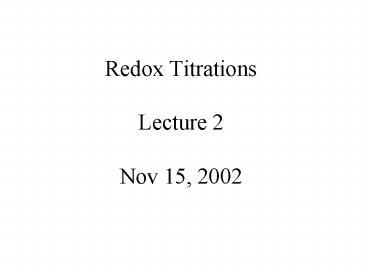Redox Titrations Lecture 2 Nov 15, 2002 - PowerPoint PPT Presentation
1 / 16
Title:
Redox Titrations Lecture 2 Nov 15, 2002
Description:
One of the most common redox titrations involve either using iodine (I2) as a ... reaction is prevented by using freshly boiled deionized water as the solvent and ... – PowerPoint PPT presentation
Number of Views:310
Avg rating:3.0/5.0
Title: Redox Titrations Lecture 2 Nov 15, 2002
1
Redox TitrationsLecture 2Nov 15, 2002
2
- Homework Chapter 15
- Problems 11, 12, 13, 16, 17
- Due Wed, Nov 20
3
Titrations Involving Iodine
- One of the most common redox titrations involve
either using iodine (I2) as a mild oxidizing
agent or iodide (I-) as a mild reducing agent. - Iodine as oxidizing agent
- I2 2 e - 2 I -
- When iodine is used as the titrant the method is
known as iodimetry.
4
Titrations Involving Iodine
- I2 is not very soluble in water (only about
- 1.3 x 10 -3 mol/L). It solubility is increased
in the presence of excess iodide by the formation - of the triiodide (I3-) species,
- I2 I - I3
- So it is really the triiodide species, though it
will commonly be referred to as iodine that is
involved in the chemical reactions.
5
Titrations Involving Iodine
- Iodide as reducing agent
- 2 I - I2 2 e -
- When iodine is produced by the addition of an
oxidizing analyte to an excess of iodide, the
method is as iodometry.
6
Titrations Involving Iodine
- Thiosulfate (S2O3-2) is commonly used in
titration reactions involving iodine, both for
iodimetric and iodometric methods. As shown in
Tables 15-2 the iodimetric methods generally
involve an excess of standard I2 (as I3 -)
followed by back titration with standard
thiosulfate.
7
Titrations Involving Iodine
- In the iodometric methods, an excess of iodide is
added to the sample of an oxidizing analyte and a
stoichiometric amount of iodine (I2 or I3- ) is
produced. This iodine is titrated with a
standard solution of thiosulfate. This reaction
is shown on the following slide.
8
Titrations Involving Iodine
9
Titrations Involving Iodine
- The reaction with iodine needs to occur in a
solution whose pH lt 9 to prevent side reactions
which produce iodates (IO3-). Generally acetic
acid is added to the analyte mixture before
titration to assure the proper pH. In some
cases, appropriate pH buffers may also be added.
10
Titrations Involving Iodine
- The titrant solution of thiosulfate cannot be
prepared directly. It is made to an approximate
concentration and then standardized with a
primary standard oxidizing agent by iodometry.
The thiosulfate solution is unstable if the pH lt
5, undergoing the following disproportionation
reaction. - S2O3-2 2 H lt gt H2SO3 S
11
Titrations Involving Iodine
- This disproportionation reaction is prevented by
using freshly boiled deionized water as the
solvent and adding a small amount of NaOH.
Although the thiosulfate needs to be stored in a
basic solution, as mentioned earlier, its
reaction as a reductant titrant needs to occur in
an acid solution.
12
TABLE 15-2 Iodimetric titrations Titrations
with standard iodine (actually I3?)
- Species analyzed Oxidation reaction
- SO2 SO2 H2O lt gt H2SO3
- H2SO3 H2O lt gt SO24- 4H 2e-
- H2S H2S lt gt S(s) 2H 2e-
- Zn2, Cd2, M2 H2S ? MS(s) 2H
- Hg2, Pb2 MS(s) lt gt M2 S 2e-
13
TABLE 15-2 Iodimetric titrations Titrations
with standard iodine (actually I3?) continued
- Species analyzed Oxidation reaction
- Cysteine, glutathione, 2RSH lt gt RSSR
2H 2e- - mercaptoethanol
- Aldehydes H2CO 3OH- lt gt HCO2-
2H2O 2e- - Glucose (and other reducing sugar)
- O
- RCH 3OH- lt gt HCO2- 2H2O 2e-
- Ascorbic acid See next slide
- (or vitamin C)
14
Ascorbic acid (or vitamin C)
15
TABLE 15-3 Iodometric titrations Titrations of
iodine (actually I3?) produced by the analyte
- Species analyzed Reaction
- HOCl HOCl H 3I- lt gt Cl - I3-
H2O - Br2 Br2 3 I- lt gt 2 Br - I3-
- IO3- 2 IO3- 16 I - 12 H lt gt 6 I3-
6 H2O - IO4- 2 IO4- 22 I - 16 H lt gt 8
I3- 8 H2O - O2 O2 4 Mn(OH)2 2 H2O lt gt 4
Mn(OH)3 - 2 Mn(OH)3 6 H 6 I - lt gt 2 Mn2
2 I3- 6 H2O - H2O2 H2O2 3 I - 2H lt gt I3- 2 H2O
16
TABLE 15-3 Iodometric titrations Titrations of
iodine (actually I3?) produced by the analyte
continued
- Species analyzed Reaction
- O3 O3 3 I - 2 H lt gt O2 I3-
H2O - NO2- 2 HNO2 2 H 3 I - lt gt 2 NO
I3- 2 H2O - S2O82- S2O82- 3 I - lt gt 2 SO42-
I3- - Cu2 2 Cu2 5 I - lt gt 2 CuI(s)
I3- - MnO4- 2 MnO4- 16 H 15 I - lt gt 2
Mn2 5 I3- 8 H2O - MnO2 MnO2(s) 4 H 3 I - lt gt Mn2
I3- 2 H2O

